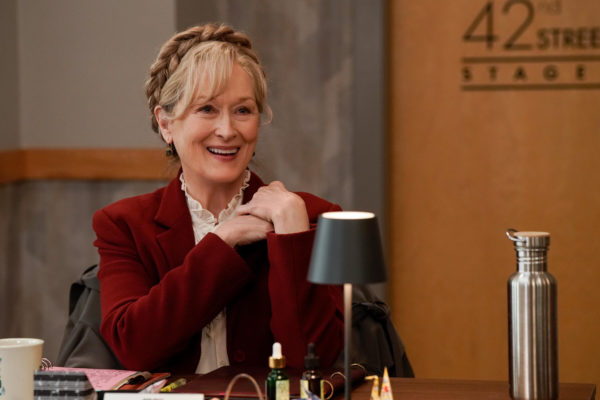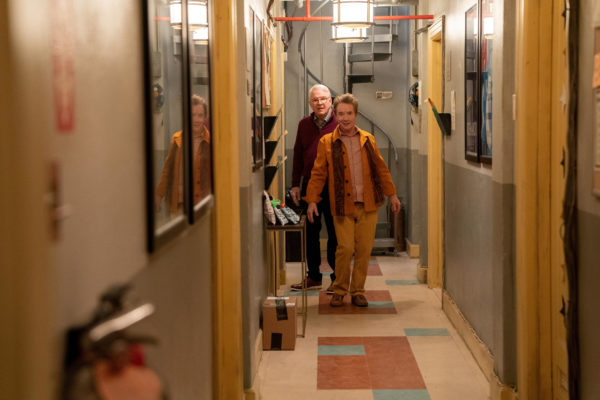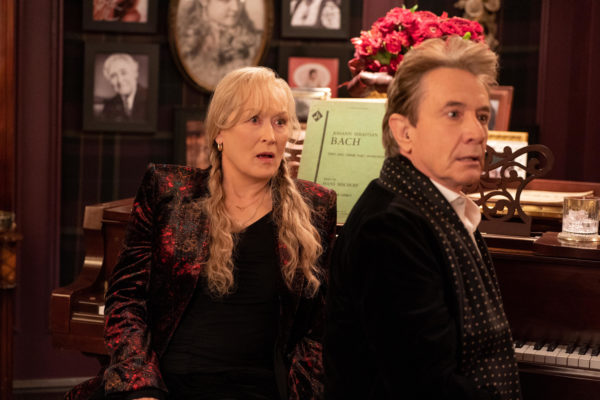
The podcast sleuths return for a third season as ‘Only Murders in the Building’ heads to Broadway to solve the case of the murdered leading man.
Considering the connections that executive producers Martin Short, Steve Martin, and Selena Gomez have, it’s no surprise that each season of Only Murders in the Building manages to pull in a bevy of supporting stars and cameo appearances.
S03 alone features heavy hitters Meryl Streep (as Loretta Durkin, an undiscovered talent and love interest for Short’s Oliver) and Paul Rudd (as Ben Glenroy, a diva-esque leading man). There’s also a host of other folks such as Jesse Williams (as documentarian Tobert), Matthew Broderick (as himself), Andrea Martin (as Joy, Charles’ former make-up artist and current love interest) and Joy Ride‘s Ashley Park (as theater troupe member Kimber).
That’s to say nothing of the returning roster of folks like Tina Fey (as duplicitous podcaster Cinda Canning), Jane Lynch (as stuntwoman Sazz Pataki), Jackie Hoffman (as gossipy building resident Uma) and Michael Cyril Creighton (as cat-obssessed resident Howard).
Besides the star studded cast and the 30-35 minute episode run time, Only Murders in the Building continues to mine the audience’s interest in true cold and mysteries. As a reminder: S02 ended with the cliffhanger death of Ben on stage at the debut of Oliver’s Broadway production. The premiere briefly jumps back approximately a year to set up that cliffhanger and introduce the characters before spending the rest of the season chronicling the aftermath.
The first two episodes are admittedly a little rocky, particularly as Streep and Rudd settle into their roles. Things get into a rhythm in episode three, “Grab Your Hankies” as Oliver desperately reconfigures his play ‘Death Rattle’ into a musical, ‘Death Rattle Dazzle’ in an effort to woo money out of not-so-subtly incestuous mother & son producer pair Donna (Linda Emond) and Cliff. The episode also features a great dig at how IP properties have taken over TV (at Grey’s Anatomy expense) and Streep sings the house down with her power ballad, “Nanny’s Lament”.

From there the season does a reasonable job of fleshing out storylines for each of the three leads, though Charles is arguably short-changed with his “white room” fears about public singing and his tumultuous relationship with Joy, which fails to amount to much (It also fails to let veteran comedienne Martin be much more than a fish obsessive, which is criminal).
Gomez’s Mabel, meanwhile, is struggling with the transition to “adult” life as she faces eviction from her aunt’s apartment in the Arconia. The youngest of the trio winds up lost without a murder investigation to keep their friendship alive; her career overall lacks direction, which puts her in a fragile spot. Oliver, meanwhile, is falling for his kooky leading lady while combating the health risks that accompany the stress of mounting a comeback on the Great White Way.

All of this intersects with the usual interviews, close calls, romantic entanglements, and humourous visits to the newly decked out penthouse (a sight gag involving Ben’s superhero action franchise CoBro is worth the price of admission alone).
And while the series is still missing the effortless energy of the first season, season three at least feels closer in tone and comedic spirit than season two, which often suffered from an aimless narrative and a tendency to strand its characters in separate subplots. Here, at least, the musical keeps most everyone coming back together, even if the supporting cast tends to flow in and out (including Streep, who basically appears every other episode).
Overall, however, the series remains a fun, breezy, star-studded comedy caper anchored by three delightful performances. Audiences who have enjoyed previous seasons will no doubt continue to do so with its third. 4/5

Other Observations:
- While Rudd’s Ben basically exists to be a foil for other characters, the emotional connection that Mabel feels to him, and how it ties back to her fractured childhood, is actually quite powerful. It’s so much more than the simple crush it is initially presented as.
- Charles’ Patter song about the Ipswich triplets has a few too many (unfunny) white room detours, but the culmination of this arc in episode eight is quite satisfying. Kudos, too, for Martin’s tour de force musical performance.
- While Loretta’s lullaby is also impressive (it seems Streep has become a stronger singer since Into The Woods), the purported showstopper by the ensemble is a bit meh. Donna’s soliloquy to Oliver about the need to find a showstopper that will entice audiences to travel from Des Moines to New York, however? Genius.
- Cinda’s few appearances suggest a larger role to come in the final two episodes or simply that Fey enjoys playing the character. The character is sheer caricature, who has – in the one year interim – been cancelled and is faking a healing journey until she can return to murder. It’s a pretty spot on depiction of white women’s privilege and Fey is eating it up.
- Williams spends most of the season playing an aloof red herring who woos Mabel, but Tobert never truly emerges as a character. It’s something of a waste of the actor. Ditto Park, whose Kimber gets some fun stuff in the first few episodes before taking a backseat as the season progresses (ironically just like Kimber does to Loretta).
- Despite lacking romantic chemistry, the dinner date between Short and Streep is quite amusing. Production designer Curt Beech really outdid himself on the look on Loretta’s cramped NY apartment.
Only Murders in the Building debuts Aug 8 with weekly episodes released every Tuesday on Hulu and Disney+ (in Canada)